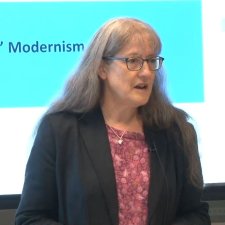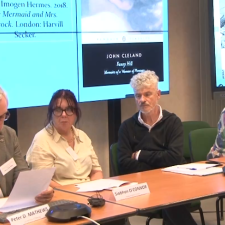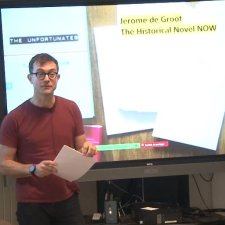Notice
Session_5 - Neo-Victorian Biofictional narratives and Neo-historical poetry (Chair : Charlotte Wadoux)
- document 1 document 2 document 3
- niveau 1 niveau 2 niveau 3
Descriptif
COLLOQUE INTERNATIONAL ANNUEL
SOCIETE D ETUDE ANGLAISES CONTEMPORAINES
The (Neo-)Historical in British Literature and Visual Arts (20th-21st c.)
Jana Valová (Masaryk University in Brno, Czech Republic) “Unveiling the Ordinary “Other” in Neo-Victorian Biofiction”
Jana Valová focuses on two Neo-Victorian narratives that experiment with the issue of invisibility and ordinariness, portraying servant characters with multifaceted desires and natures in Lady’s Maid (1990) by Margaret Forster and The Mistress of Nothing (2009) by Kate Pullinger.
Barbara Braid (University of Szczecin, Poland), “Reclaiming apparitional lesbians in neo-Victorian biofiction: Gentleman Jack versus Learned by Heart”
Barbara Braid examines revisionist TV series Gentleman Jack (HBO/BBC 2019-2022) that establishes Ann Lister as a biomyth and Emma Donoghue’s novel Learned by Heart (2023) that recovers the largely unknown character of Lister’s first lover, Eliza Raine. Questions addressed include whether in the effort to recover some voices from the past, neo-Victorian biofictions detract from or distort the others and the creation of authenticity and reparative historiography through fictionality and imagination.
Isabelle Roblin (Université du Littoral-Côte d’Opale, France) “Graeme Macrae Burnet’s His Bloody Project (2015): a Slippery Neo-Historical Novel”
Isabelle Roblin discusses how His Bloody Project couples a postmodern presentation with the use of scrupulous similitude notably in terms of setting and language which makes it a neo-historical novel.
Dans la même collection
-
Lucy Caldwell, winner of the 2023 Walter Scott Prize for Historical Fiction with These Days
CaldwellLucyLucy Caldwell, winner of the 2023 Walter Scott Prize for Historical Fiction with These Days
-
Diana Wallace, University of South Wales, UK "Ought it not all be re-written instantly ? : modernis…
Diana Wallace, University of South Wales, UK "Ought it not all be re-written instantly ? : modernism and the re-invention of historical fiction"
-
Session 4 - Neo-Mythical fiction (chair : Jean-Michel Ganteau)
Session 4 - Neo-Mythical fiction (chair : Jean-Michel Ganteau)
-
Session 3 - Art and materialities (chair : Vanessa Guignery)
Session 3 - Art and materialities (chair : Vanessa Guignery)
-
Session 2 - Figures of marginality (chair: Isabelle Roblin)
Session 2 - Figures of marginality (chair: Isabelle Roblin)
-
“The historical novel NOW”, Jerome de Groot, University of Manchester, UK
“The historical novel NOW”, Jerome de Groot, University of Manchester, UK
-
Session 1 - Variations on biofiction (Chair : Georges Letissier)
Session 1 - Variations on biofiction (Chair : Georges Letissier)
-









